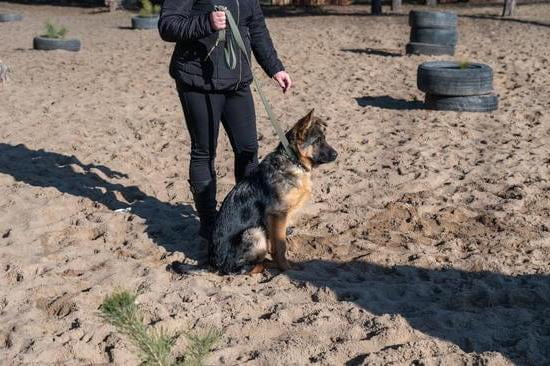Are you struggling with keeping your dog contained within your yard? If so, learning how to train your dog with an electric fence could be the solution you’ve been searching for.
Many pet owners have found success in using electric fences to safely and effectively contain their furry friends within designated areas. In this article, we will explore the ins and outs of electric fence training for dogs, including the benefits and limitations, selecting the right system, preparation and set up, step-by-step training guide, addressing common challenges, reinforcing positive behavior, ensuring safety during training, and troubleshooting common issues.
When it comes to training your dog with an electric fence, it’s important to understand both the benefits and limitations of this approach. While it can provide a safe and effective way to contain your dog without the need for traditional physical barriers, it’s also essential to consider potential challenges and safety concerns. Additionally, selecting the right electric fence system for your specific needs and your dog’s unique personality is crucial for successful training.
As you delve into the world of electric fence training for dogs, there are various factors to consider in order to ensure a smooth and effective training process. From preparation and set up of the electric fence system to addressing common challenges that may arise during training, it’s important to approach this method with careful planning and consideration for both your dog’s well-being and safety.
By following a step-by-step guide on introducing your dog to the electric fence system coupled with reinforcing positive behavior through proper training techniques, you can help ensure a positive experience for both you and your furry companion.
Understanding the Benefits and Limitations of Using an Electric Fence
Benefits of Using an Electric Fence
One of the primary benefits of using an electric fence for dog training is the ability to set clear boundaries without the need for physical barriers. This can be especially useful for households with large yards or rural properties where traditional fencing may not be feasible or cost-effective. Additionally, electric fences allow dogs to have more freedom to roam and explore within a specified area while still remaining safe and contained.
Another benefit is the flexibility and ease of installation of electric fences. Unlike traditional fencing, electric fences can be set up relatively quickly and can easily accommodate different shapes and sizes of outdoor spaces. They can also be easily adjusted if needed, making them a convenient option for dog owners.
Limitations of Using an Electric Fence
While electric fences have their benefits, it’s important to also consider their limitations. One major limitation is that some dogs may not respond well to electric stimulation, leading to fear, anxiety, or even aggression. It’s essential for dog owners to carefully assess their dog’s temperament and behavior before considering an electric fence as a training tool.
Additionally, electric fences may not always prevent other animals or people from entering the containment area. This can pose a risk if there are aggressive wildlife or unfamiliar individuals in the vicinity. It’s crucial for dog owners to weigh these limitations when deciding whether to use an electric fence for their dog.
Ensuring Responsible Use
It’s important for dog owners to understand that using an electric fence comes with a level of responsibility. Proper training and supervision are key components in ensuring that the system is used effectively and safely.
Understanding your individual dog’s needs and behavior is essential in making sure that they are comfortable with the training process and that their well-being is prioritized throughout. Leading experts recommend consulting with professional trainers who specialize in positive reinforcement methods when incorporating an electric fence into your dog’s training routine.
Selecting the Right Electric Fence System for Your Dog
When it comes to selecting the right electric fence system for your dog, there are several factors to consider to ensure the safety and effectiveness of the training. The first thing you need to do is determine the size and temperament of your dog. If you have a large or aggressive breed, you may need a stronger electric fence system compared to a smaller or more docile dog.
Another important factor to consider is the area that you want to contain your dog in. Some electric fence systems are designed for larger areas, while others are suited for smaller yards or properties. It’s crucial to measure the perimeter of the area where you want to install the electric fence to determine the appropriate system for your needs.
Additionally, take into consideration the durability and reliability of the electric fence system. Look for brands that are known for their quality and longevity. It’s essential that the system can withstand various weather conditions and potential wear and tear from everyday use.
Furthermore, consider whether you want additional features such as remote training options or compatibility with other pet containment products. Some electric fence systems offer advanced technology that allows you to monitor your dog’s behavior and adjust settings remotely. Research different brands and models to find one that aligns with your specific preferences and requirements.
In summary, selecting the right electric fence system for your dog requires careful consideration of your dog’s size and temperament, as well as the size of the containment area and durability of the system. By taking these factors into account, you can ensure that your dog will receive safe and effective training with an electric fence.
| Factors | Considerations |
|---|---|
| Size & Temperament of Dog | Large/aggressive breed vs small/docile breed |
| Area Size | Determine perimeter for appropriate system |
| Durability & Reliability | Look for quality, weather-resistant brands/models |
| Additional Features | Remote training options, compatibility with other products |
Preparation and Set Up of the Electric Fence
When preparing to train your dog with an electric fence, it is important to ensure that you have the right system in place and that it is properly set up for effective training. Here are some steps on how to prepare and set up the electric fence for your dog:
- Choose a suitable location: The first step in setting up your electric fence is to choose an appropriate area where you want to contain your dog. This could be your yard, garden, or any other designated space. Ensure that the area is clear of any debris, objects, or obstacles that could interfere with the proper function of the electric fence.
- Install the perimeter wire: Once you’ve chosen a location, it’s time to install the perimeter wire that will define the boundaries of the containment area. Follow the manufacturer’s instructions carefully and ensure that the wire is properly buried or secured around the perimeter of the designated area.
- Set up the transmitter and receiver collar: The next step is to install and set up the transmitter unit, which will send signals through the perimeter wire, and then attach the receiver collar to your dog. Ensure that both devices are functioning properly before proceeding with training.
It’s crucial to follow these steps meticulously to ensure that your electric fence system is set up correctly for effective training.
Proper preparation and setup of an electric fence system are essential for successful training. It ensures that all components of the system are functioning correctly and minimizes any potential issues during training. With careful preparation, you can create a safe and secure environment for your dog while using an electric fence.
By following these steps on how to prepare and set up an electric fence for your dog, you can create a conducive environment for effective training with this containment method.
Step-by-Step Guide on How to Introduce Your Dog to the Electric Fence
Introducing your dog to an electric fence requires patience, consistency, and positive reinforcement. Here’s a step-by-step guide on how to train your dog with an electric fence:
1. Set the boundaries: Before introducing your dog to the electric fence, it’s important to set the boundaries of where they can roam freely. This can be done by placing flags along the perimeter of the area that is safe for your dog to explore.
2. Introduce the collar: Once the boundaries are set, introduce your dog to the electric fence collar. Let them become familiar with the collar by allowing them to sniff it and gradually putting it on for short periods of time while inside the house.
3. Teach through beeps: Most electric fences have a warning beep that alerts your dog when they are approaching the boundary. Take your dog on a leash towards the perimeter and allow them to hear the warning beep. When they hear it, immediately redirect their attention back into the safe zone.
4. Use static correction: After your dog understands the warning beep, it’s time to introduce them to static correction. As they approach the boundary, they will receive a mild static correction from the collar. This should not be harmful but rather serve as a deterrent to crossing the boundary.
5. Reinforce positive behavior: Whenever your dog responds appropriately by staying within the boundaries, provide praise and rewards such as treats or verbal affirmation. Positive reinforcement will help them associate staying within their territory with a pleasant experience.
By following these steps and remaining consistent in training, you can effectively teach your dog how to respect and stay within their designated area using an electric fence system.
Addressing Common Challenges During the Training Process
Training your dog with an electric fence can come with its own set of challenges, but with patience and perseverance, these obstacles can be overcome. One common challenge is ensuring that your dog understands the boundaries set by the electric fence. Some dogs may initially test the limits and try to escape, but consistent training and positive reinforcement can help them learn where they are allowed to roam.
Another challenge pet owners often face is dealing with fear or anxiety in their dogs when it comes to the electric fence. Some dogs may develop a fear of going outside altogether, while others may become anxious whenever they approach the boundaries. It’s important to take a gradual approach when introducing your dog to the electric fence and to provide plenty of positive reinforcement to help them feel comfortable and secure within their designated area.
Additionally, some dogs may exhibit stubborn behavior during the training process. They may refuse to respect the boundaries or ignore commands when it comes to the electric fence. Consistency is key in this situation – be firm with your training methods and make sure that your dog understands that there are consequences for disregarding the rules.
| Common Challenges | Solutions |
|---|---|
| Testing boundaries | Consistent training and positive reinforcement |
| Fear or anxiety | Gradual introduction and plenty of positive reinforcement |
| Stubborn behavior | Consistency in training methods and enforcing consequences |
Tips for Reinforcing Positive Behavior With the Electric Fence
Reinforcing positive behavior is crucial when training your dog with an electric fence. While the fence serves as a physical barrier, it is equally important to implement positive reinforcement techniques to ensure that your dog understands the boundaries and behaves accordingly.
Consistent Positive Reinforcement
Consistency is key when using an electric fence to train your dog. Whenever your dog stays within the designated boundaries of the fence, it’s essential to provide positive reinforcement, such as verbal praise or treats. This will help your dog associate staying within the boundary with positive outcomes, encouraging them to continue behaving in the desired manner.
Regular Training Sessions
Regular and consistent training sessions are necessary for reinforcing positive behavior with the electric fence. Spend time each day walking around the perimeter of the fence with your dog, gently guiding them back if they approach the boundary. Over time, your dog will learn to stay within the designated area without needing as much guidance.
Monitor Your Dog’s Behavior
Observing your dog’s behavior around the electric fence is crucial for identifying opportunities to reinforce positive behavior. Keep an eye on how they react when nearing the boundary and provide immediate reinforcement for appropriate responses. Additionally, pay attention to any signs of anxiety or stress and adjust your training approach accordingly.
By implementing consistent positive reinforcement, regular training sessions, and monitoring your dog’s behavior, you can effectively reinforce positive behavior while training them with an electric fence. These techniques will contribute to a successful and safe training process for both you and your beloved pet.
Ensuring Safety and Well-Being During and After Training
When it comes to training your dog with an electric fence, safety and well-being should be top priorities throughout the entire process. While electric fences can be effective tools for keeping your dog contained within a certain area, it is important to ensure that the training and use of the fence are done in a way that prioritizes your pet’s safety and comfort.
One key aspect of ensuring safety during electric fence training is to introduce the system gradually and with care. This means taking the time to properly set up the fence according to manufacturer guidelines, and then slowly introducing your dog to the boundaries.
It’s important to monitor your dog’s reaction closely during this process, looking for signs of stress or discomfort. Additionally, always make sure that the electric fence is properly maintained and functioning correctly to avoid any potential harm to your pet.
After training, it’s crucial to continue prioritizing your dog’s well-being by regularly inspecting the electric fence system for any malfunctions or damage. Routine checks will help ensure that the fence remains a safe containment option for your pet. Additionally, it’s essential to provide positive reinforcement and praise when your dog respects the boundaries of the electric fence, further reinforcing their understanding of how it works.
Ultimately, safety and well-being go hand in hand with effective training when it comes to using an electric fence for dogs. By being mindful of these factors throughout every step of the process, you can successfully train your dog while keeping them safe and comfortable within their designated boundary area.
Troubleshooting and Troubleshooting Common Issues With Electric Fence Training
Training your dog with an electric fence can be an effective way to keep them safe within your property boundaries. However, as with any training method, there can be challenges and issues that arise during the process. In this section, we will discuss some common problems that may occur when using an electric fence system and provide tips on how to troubleshoot and address these issues.
One common issue that dog owners may encounter during electric fence training is a lack of response from their pet. Some dogs may not understand the concept of the boundary and may continue to cross over it despite receiving a corrective shock.
In such cases, it is important to revisit the initial steps of introducing your dog to the electric fence. Spend more time on leash training within the perimeter, using positive reinforcement techniques to help your dog understand where they should and should not go.
Another common issue with electric fence training is inconsistent boundaries or signal interference. This can lead to confusion for your dog and make it difficult for them to understand where the boundary lies. To address this, ensure that the transmitter is placed in an area free from metal objects or other electronic devices that could cause interference. Additionally, check the boundary wire for any breaks or damage that could be causing inconsistencies in the signal.
It’s also important to consider your dog’s individual temperament and behavior during electric fence training. Some dogs may be more sensitive to the corrective shock than others, while some may have a higher tolerance for discomfort.
Take this into account when setting the level of correction on the collar and be mindful of your pet’s reaction during training sessions. Adjustments may need to be made based on your dog’s response in order to ensure that they are learning effectively without experiencing unnecessary stress or anxiety.
Conclusion and Final Thoughts on the Effectiveness of Electric Fence Training for Dogs
In conclusion, electric fence training can be an effective and humane way to contain and train your dog within the boundaries of your property. When done correctly, electric fence training provides a safe and reliable means of allowing your dog the freedom to roam while keeping them safe from harm. By following the step-by-step guide provided in this article, you can ensure that your dog understands the boundaries and learns to respect them.
It is important to remember that electric fence training is not a one-size-fits-all solution. The effectiveness of electric fence training for dogs depends on various factors including the temperament and breed of the dog, as well as consistent and patient training from the owner. While it may not be suitable for every dog, when used appropriately, an electric fence system can provide both you and your pet with peace of mind.
Ultimately, the key to successful electric fence training lies in proper preparation, consistent reinforcement of positive behavior, and addressing any challenges that may arise during the training process. By selecting the right system for your dog, taking the time to introduce them to the fence gradually, and reinforcing their understanding of the boundaries, you can create a secure environment for your pet while allowing them the freedom they desire.
Therefore, if you are considering how to train your dog with an electric fence system, following these guidelines will help ensure a successful outcome for both you and your furry friend.
Frequently Asked Questions
How Long Does It Take a Dog to Get Used to an Electric Fence?
The time it takes for a dog to get used to an electric fence can vary depending on the individual dog. Some dogs may adjust within a few days, while others may take weeks. It’s important to introduce the fence gradually and consistently.
Do Electric Fences Work on Dogs?
Electric fences can be effective in containing dogs within a specific area, but their success also depends on proper training and supervision. Some dogs may learn to respect the boundaries quickly, while others may require more time and effort.
Is It Hard to Train a Dog With Invisible Fence?
Training a dog with an invisible fence can be challenging, especially if the dog is not familiar with boundaries or has a strong prey drive. Consistent training, positive reinforcement, and patience are key to successfully teaching a dog to respect an invisible fence.

Welcome to the blog! I am a professional dog trainer and have been working with dogs for many years. In this blog, I will be discussing various topics related to dog training, including tips, tricks, and advice. I hope you find this information helpful and informative. Thanks for reading!





